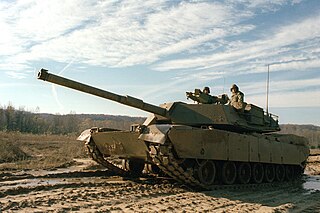
A kinetic energy penetrator is a type of ammunition designed to penetrate vehicle armour using a flechette-like, high-sectional density projectile. Like a bullet, this type of ammunition does not contain explosive payloads and uses purely kinetic energy to penetrate the target. Modern KEP munitions are typically of the armour-piercing fin-stabilized discarding sabot (APFSDS) type.
A longsword is a type of European sword characterized as having a cruciform hilt with a grip for two-handed use, a straight double-edged blade of around 85 to 110 cm, and weighing approximately 1 to 1.5 kg.

Chobham armour is the informal name of a composite armour developed in the 1960s at the British tank research centre on Chobham Common, Surrey. The name has since become the common generic term for composite ceramic vehicle armour. Other names informally given to Chobham armour include "Burlington" and "Dorchester". "Special armour" is a broader informal term referring to any armour arrangement comprising "sandwich" reactive plates, including Chobham armour.

Vitreous enamel, also called porcelain enamel, is a material made by fusing powdered glass to a substrate by firing, usually between 750 and 850 °C. The powder melts, flows, and then hardens to a smooth, durable vitreous coating. The word comes from the Latin vitreum, meaning "glass".

Repoussé or repoussage is a metalworking technique in which a malleable metal is shaped by hammering from the reverse side to create a design in low relief. Chasing or embossing is a similar technique in which the piece is hammered on the front side, sinking the metal. The two techniques are often used in conjunction.

Plate armour is a historical type of personal body armour made from bronze, iron, or steel plates, culminating in the iconic suit of armour entirely encasing the wearer. Full plate steel armour developed in Europe during the Late Middle Ages, especially in the context of the Hundred Years' War, from the coat of plates worn over mail suits during the 14th century.

A greave or jambeau is a piece of armour that protects the leg.

Kabuto is a type of helmet first used by ancient Japanese warriors which, in later periods, became an important part of the traditional Japanese armour worn by the samurai class and their retainers in feudal Japan.

The poleaxe is a European polearm that was widely used by medieval infantry.

Medieval technology is the technology used in medieval Europe under Christian rule. After the Renaissance of the 12th century, medieval Europe saw a radical change in the rate of new inventions, innovations in the ways of managing traditional means of production, and economic growth. The period saw major technological advances, including the adoption of gunpowder, the invention of vertical windmills, spectacles, mechanical clocks, and greatly improved water mills, building techniques, and agriculture in general.

Sheet metal is metal formed by an industrial process into thin, flat pieces. Sheet metal is one of the fundamental forms used in metalworking, and it can be cut and bent into a variety of shapes. Countless everyday objects are fabricated from sheet metal. Thicknesses can vary significantly; extremely thin sheets are considered foil or leaf, and pieces thicker than 6 mm (0.25 in) are considered plate steel or "structural steel".

Electrowinning, also called electroextraction, is the electrodeposition of metals from their ores that have been put in solution via a process commonly referred to as leaching. Electrorefining uses a similar process to remove impurities from a metal. Both processes use electroplating on a large scale and are important techniques for the economical and straightforward purification of non-ferrous metals. The resulting metals are said to be electrowon.

A target ship is a vessel — typically an obsolete or captured warship — used as a seaborne target for naval gunnery practice or for weapons testing. Targets may be used with the intention of testing effectiveness of specific types of ammunition; or the target ship may be used for an extended period of routine target practice with specialized non-explosive ammunition. The potential consequences of a drifting wreck require careful preparation of the target ship to prevent pollution, or a floating or submerged collision risk for maritime navigation.
This article is a list of terms commonly used in the practice of metalworking – the science, art, industry, and craft of shaping metal.

All electronic devices and circuitry generate excess heat and thus require thermal management to improve reliability and prevent premature failure. The amount of heat output is equal to the power input, if there are no other energy interactions. There are several techniques for cooling including various styles of heat sinks, thermoelectric coolers, forced air systems and fans, heat pipes, and others. In cases of extreme low environmental temperatures, it may actually be necessary to heat the electronic components to achieve satisfactory operation.

Roman military personal equipment was produced in small numbers to established patterns, and used in an established manner. These standard patterns and uses were called the res militaris or disciplina. Its regular practice during the Roman Republic and Roman Empire led to military excellence and victory. The equipment gave the Romans a very distinct advantage over their barbarian enemies, especially so in the case of armour. This does not mean that every Roman soldier had better equipment than the richer men among his opponents. According to Edward Luttwak, Roman equipment was not of a better quality than that used by the majority of Rome's adversaries. Other historians and writers have stated that the Roman army's need for large quantities of "mass produced" equipment after the Marian Reforms and subsequent civil wars led to a decline in the quality of Roman equipment compared to the earlier Republican era:
The production of these kinds of helmets of Italic tradition decreased in quality because of the demands of equipping huge armies, especially during civil wars...The bad quality of these helmets is recorded by the sources describing how sometimes they were covered by wicker protections, like those of Pompeius' soldiers during the siege of Dyrrachium in 48 BC, which were seriously damaged by the missiles of Caesar's slingers and archers.
It would appear that armour quality suffered at times when mass production methods were being used to meet the increased demand ..." and "...the reduced size curiasses would also have been quicker and cheaper to produce, which may have been a deciding factor at times of financial crisis, or where large bodies of men were required to be mobilized at short notice, possibly reflected in the poor-quality, mass produced iron helmets of Imperial Italic type C, as found, for example, in the River Po at Cremona, associated with the Civil Wars of AD 69 AD; Russel-Robinson, 1975, 67
Up until then, the quality of helmets had been fairly consistent and the bowls well decorated and finished. However, after the Marian Reforms, with their resultant influx of the poorest citizens into the army, there must inevitably have been a massive demand for cheaper equipment, a situation which can only have been exacerbated by the Civil Wars...

A shield boss, or umbo, is a round, convex or conical piece of material at the centre of a shield. Shield bosses are usually made of thick metal but could also be made of wood. The boss was originally designed to deflect blows from the centre of round shields, though they also provided a place to mount the shield's grip. As time went on and heater shields with curved bodies became more popular, and enarmes superseded the bar grip, the boss became more of an ornamental piece.

Raising is a metalworking technique whereby sheet metal is formed over a solid object by repeated "courses" of hammering and annealing. A sheet metal worker is often required to raise, or bump, the work into form from the flat metal by means of a raising hammer and raising block. The raising block is made from substance giving resistance to the blows.

Planishing is a metalworking technique that involves finishing the surface by finely shaping and smoothing sheet metal.
A semiconductor package is a metal, plastic, glass, or ceramic casing containing one or more discrete semiconductor devices or integrated circuits. Individual components are fabricated on semiconductor wafers before being diced into die, tested, and packaged. The package provides a means for connecting it to the external environment, such as printed circuit board, via leads such as lands, balls, or pins; and protection against threats such as mechanical impact, chemical contamination, and light exposure. Additionally, it helps dissipate heat produced by the device, with or without the aid of a heat spreader. There are thousands of package types in use. Some are defined by international, national, or industry standards, while others are particular to an individual manufacturer.


















